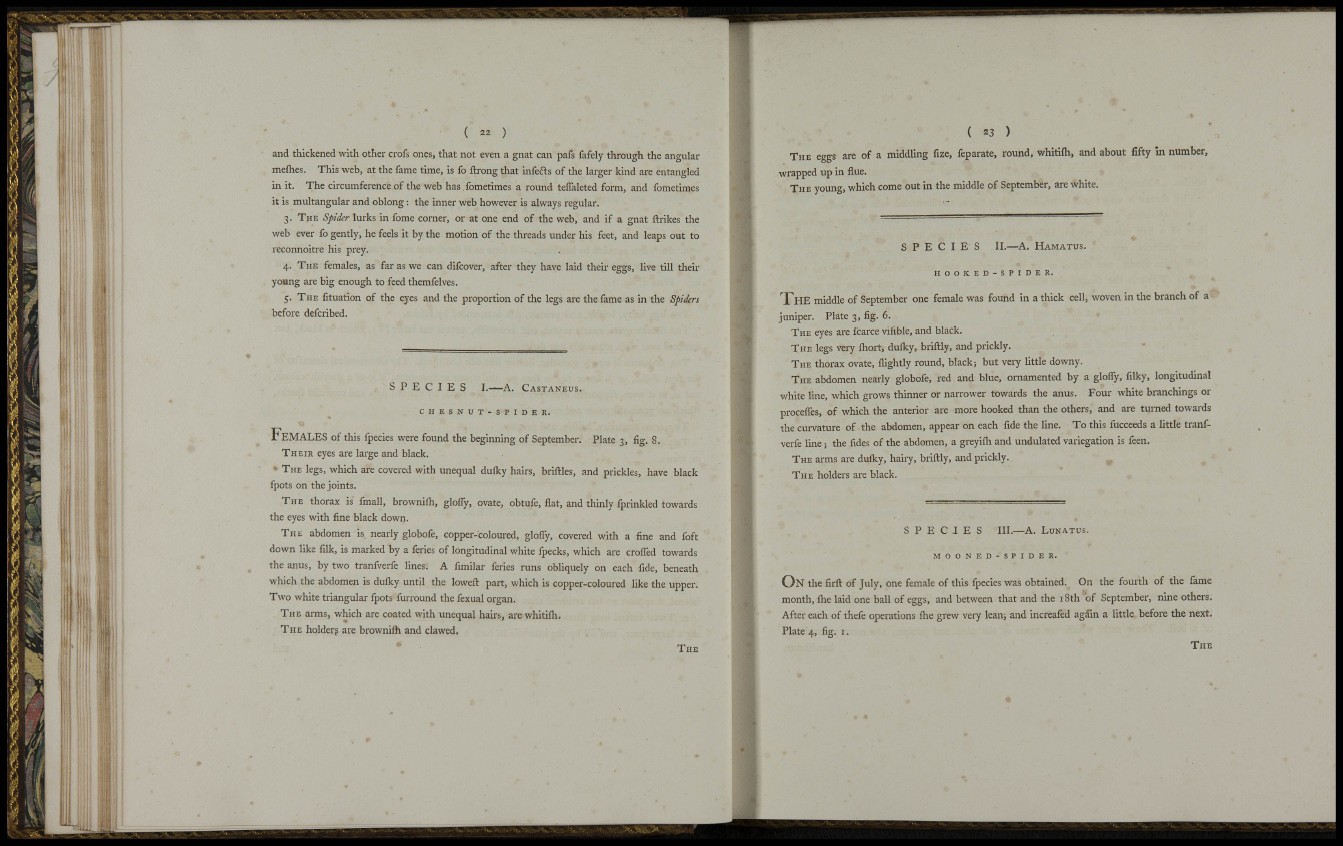
fiiîill I BtSi
-I
is ii
V;
and thickened with other crofs ones, that not even a gnat can pafs fafely through the angular
mefhes. This web, at the fame time, is fo ftrong that infefts of the larger kind are entangled
in it. The circumference of the web has. fometimes a round teflaleted form, and fometimes
it is multangular and oblong: the inner web however is always regular.
3. THE Sp'Jer lurks in fome corner, or at one end of the web, and if a gnat ftrikes the
web ever fo gently, he feels it by the motion of the threads under his feet, and leaps out to
reconnoitre his prey.
4. THE females, as far as we can difcover, after they have laid their eggs, live till their
young are big enough to feed themfelves.
5. THE fituation of the eyes and the proportion of the legs are the fame as in the Spiders
before defcribed.
S P E C I E S I.—A. CASTANEUS.
C H E S N U T - S P I D E R .
FEMALES of this fpecies were found the beginning of September. Plate 3, fig. 8.
T H E I R eyes are large and black.
• THE legs, which are covered with unequal duiky hairs, briftles, and prickles, have black
fpots on the joints.
THE thorax is fmall, brownifli, glofly, ovate, obtufe, flat, and thinly fprinkled towards
the eyes with fine black down.
THE abdomen is nearly globofe, copper-coloured, glofly, covered with a fine and foft
down like filk, is marked by a feries of longitudinal white fpecks, which are crofled towards
the anus, by two tranfverfe lines. A flmilar feries runs obliquely on each fide, beneath
which the abdomen is duflcy until the lowefl: part, which is copper-coloured like the upper.
TWO white triangular fpots furround the fexual organ.
THE arms, which are coated with unequal hairs, are whitifli.
THE holder? are browniih and clawed.
T H E
lii'l
( 23 )
THE eggs are of a middling fize, feparate, round, whitiih, and about fifty in number,
wrapped tip in flue.
THE young, which come out in the middle of September, are white.
S P E C I E S II.—A. HAMATUS.
H O O K E D - S P I D E R .
T H E middle of September one female was found in a thick cell, woven in the branch of a
juniper. Plate 3, fig. 6.
THE eyes are fcarce vifible, and black.
THE legs very fliort, duflcy, briftly, and prickly.
THE thorax ovate, flightly round, black; but very little downy.
THE abdomen nearly globofe, red and blue, ornamented by a glofly, filky, longitudinal
white line, which grows thinner or narrower towards the anus. Four white branchings or
proceflTes, of which the anterior are more hooked than the others, and are turned towards
the curvature of the abdomen, appear on each fide the line. To this fucceeds a little tranfverfe
line; the fides of the abdomen, a greyifli and undulated variegation is feen.
THE arms are duflcy, hairy, briflily, and prickly.
THE holders are black.
S P E C I E S III.—A. LUNATUS.
M O O N E D - S P I D E R .
O N the firfl: of July, one female of this fpecies was obtained. On the fourth of the fame
month, flie laid one ball of eggs, and between that and the i8th of September, nine others.
After each of thefe operations flie grew very lean; and increafed again a little before the next.
Plate 4, fig. I.
T H E